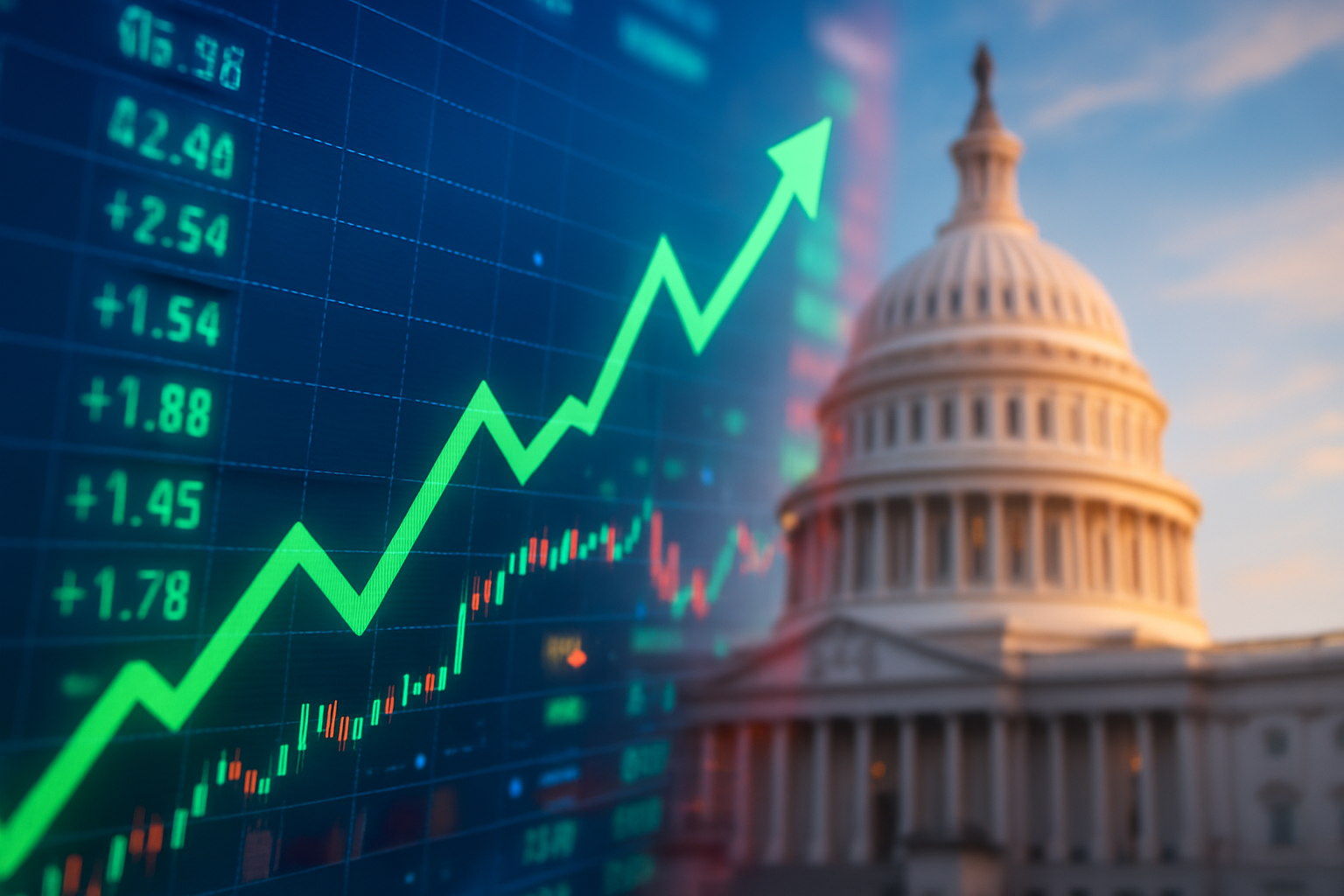
Washington D.C. – November 10, 2025 – The United States federal government finds itself in an unprecedented fiscal quagmire, entering its 41st day of the longest shutdown in the nation's history. The impasse, which began on October 1, 2025, after a failure to pass appropriations legislation for the 2026 fiscal year, has led to the furlough of approximately 900,000 federal employees and left another two million working without immediate pay. However, a significant legislative breakthrough over the weekend has ignited a wave of optimism across financial markets today, with major indices rallying on hopes of an imminent resolution.
The protracted standoff has cast a long shadow of uncertainty over the U.S. economy, impacting everything from government services to the release of vital economic data. Today's market surge reflects a collective sigh of relief from investors who have been grappling with weeks of political gridlock and its potential economic fallout. While the path to fully reopening the government still requires navigating the House of Representatives and securing a presidential signature, the Senate's decisive action has provided a much-needed catalyst for positive market sentiment.
Breakthrough on Capitol Hill Sparks Market Optimism
The latest developments unfolded rapidly over the weekend. On Sunday, November 9, the Senate achieved a crucial procedural hurdle by advancing a bipartisan compromise bill designed to reauthorize government funding. The measure passed with a significant 60-40 vote, notably seeing eight Democrats join the majority of Republicans in support, signaling a potential path forward from the entrenched political divide. This proposed legislation aims to extend government funding through January 30, 2026, and includes three year-long appropriations bills for various federal agencies. Crucially, it guarantees retroactive pay for furloughed federal workers and those who have been working without compensation, while also seeking to prevent further layoffs.
A key point of contention throughout the shutdown, the extension of Affordable Care Act (ACA) subsidies, was not immediately addressed in this funding package. Instead, a commitment was secured for a separate vote on this issue by mid-December, a concession that has drawn criticism from some Democrats who expressed frustration over the delay. Despite this, Senate Majority Leader John Thune expressed hopes for a final Senate vote as early as Monday, November 10. The bill's journey is far from over, however, as it still requires approval from the House of Representatives and the President's signature to officially end the shutdown. House Speaker Mike Johnson has already urged members to return to Washington in anticipation of a vote later this week, underscoring the urgency to resolve the crisis.
The immediate reaction from the stock market on Monday, November 10, was overwhelmingly positive. Investor confidence, which had been eroded by the prolonged political stalemate, surged on the prospect of reduced uncertainty. The S&P 500 (INDEXSP:.INX) jumped by 77 points, or 1.2%, reaching 6,806 in early trading. Similarly, the Dow Jones Industrial Average (INDEXDJX:.DJI) gained 320 points, or 0.7%, climbing to 47,308. The tech-heavy Nasdaq Composite (INDEXNASDAQ: .IXIC) led the charge with a notable surge of 1.8% to 1.95%, fueled by a strong rebound in major technology shares. Companies like Nvidia (NASDAQ: NVDA), Alphabet (NASDAQ: GOOGL), Tesla (NASDAQ: TSLA), Meta Platforms (NASDAQ: META), and Palantir Technologies (NYSE: PLTR) all saw significant gains, reflecting a broader "risk-on" sentiment. Even cryptocurrencies like Bitcoin climbed alongside stocks, indicating a widespread return of investor appetite for risk assets. This broad rally across Wall Street signals a release of pent-up optimism after weeks of operating in the dark due to the halt in government economic reports.
Companies Poised to Win or Lose from the Shutdown's Resolution
The resolution of a government shutdown, particularly one of this magnitude, creates a distinct set of winners and losers across various sectors. The most immediate beneficiaries are likely to be companies that rely heavily on government contracts and those whose operations or market sentiment are directly impacted by federal regulatory functions. Defense contractors, for instance, such as Lockheed Martin (NYSE: LMT) and Raytheon Technologies (NYSE: RTX), often face payment delays or project slowdowns during shutdowns. Their stock prices typically rebound as the certainty of federal spending returns. Similarly, infrastructure companies involved in federal projects could see renewed activity.
Beyond direct contractors, sectors that benefit from consumer confidence and stable economic data are also set to gain. Retailers and consumer discretionary companies, like Amazon (NASDAQ: AMZN) or Target (NYSE: TGT), often see a modest boost as furloughed federal workers receive back pay, potentially increasing consumer spending. The resumption of crucial economic data releases from agencies like the Census Bureau and Bureau of Labor Statistics will also provide much-needed clarity for businesses and investors, allowing for more informed decision-making and potentially reducing market volatility. Furthermore, the travel and tourism industry, which can suffer from reduced federal services (e.g., national park closures or passport processing delays), will likely see a positive impact. Airlines such as Delta Air Lines (NYSE: DAL) and Southwest Airlines (NYSE: LUV) often experience a lift as travel returns to normal.
Conversely, some entities might experience continued pressure or mixed reactions. Health insurers, such as Cigna (NYSE: CI) and Humana (NYSE: HUM), saw their shares dip by 1.7% and 2% respectively on Monday, November 10. This reaction stems from the continued lack of immediate clarity regarding the expiring Affordable Care Act (ACA) subsidies, which was deferred in the compromise bill. This uncertainty highlights how specific legislative details within a resolution can still create sector-specific headwinds. Furthermore, while the market generally rallies on the news of a shutdown's end, the lingering economic impact on small businesses that rely on federal permits, loans, or customers, might take longer to fully recover, even with the government reopened. Financial institutions that cater to these businesses, such as regional banks, could see a delayed return to full health.
Broader Significance and Historical Context
This protracted government shutdown, now the longest in U.S. history, transcends immediate market fluctuations, embedding itself within broader industry trends and carrying significant regulatory and policy implications. The repeated weaponization of the budget process highlights a persistent political polarization that introduces systemic risk into the U.S. economic outlook. This ongoing uncertainty can deter foreign investment, impact long-term business planning, and even influence credit ratings, as demonstrated by past threats to the U.S. sovereign debt rating. The current shutdown's impact on federal agencies, from the Environmental Protection Agency (EPA) slowing permit approvals to the Food and Drug Administration (FDA) delaying food inspections, showcases the ripple effects on various industries reliant on these regulatory functions. Companies in sectors like energy, pharmaceuticals, and agriculture face operational delays and increased compliance risks during such periods.
Historically, government shutdowns have had a varied but generally modest and often temporary impact on financial markets. The S&P 500 (INDEXSP:.INX) has typically shown resilience, often recovering any losses once the government reopens. For instance, the 2013 shutdown saw a brief dip in the market, followed by a swift recovery. The 2018-2019 shutdown, while longer, also saw markets eventually rebound. However, the current shutdown's duration and the context of an already complex global economic environment – marked by ongoing inflation concerns, supply chain adjustments, and geopolitical tensions – make its potential long-term implications more significant. This event underscores the fragility of policy stability and its direct correlation with economic confidence. It also raises questions about the efficiency of legislative processes and the need for more robust mechanisms to ensure continuous government operations, particularly concerning essential services and economic data provision.
The prolonged absence of critical economic data, such as GDP reports, inflation figures, and employment statistics, has forced investors and policymakers to operate in a "flying blind" scenario. This lack of transparency impedes accurate economic forecasting and complicates the Federal Reserve's decision-making process regarding monetary policy, including potential interest rate adjustments. The current environment also fits into a broader trend of increased government intervention and political influence on market dynamics. While market participants generally prefer stability, the recurring nature of these fiscal impasses suggests that political risk is becoming an increasingly important factor to price into valuations. The current legislative compromise, while a positive step, also highlights the ongoing partisan battles over key policy areas like healthcare, indicating that even a resolution to the shutdown may not fully alleviate underlying policy uncertainties for the long term.
What Comes Next: Navigating the Path Forward
The immediate future hinges on the successful passage of the compromise bill through the House of Representatives and its subsequent signing by President Donald Trump. While the Senate's bipartisan support offers a strong precedent, the House's dynamics can be unpredictable, and any last-minute amendments or political maneuvering could introduce further delays or even derail the agreement. Should the bill pass, the short-term outlook for the market is likely one of continued positive momentum, as the cloud of uncertainty lifts and the flow of government services and economic data resumes. This could lead to a sustained "risk-on" environment, with investors reallocating capital towards growth-oriented assets and sectors that were previously constrained by the shutdown.
In the long term, however, the recurring nature of government shutdowns necessitates strategic pivots and adaptations from businesses and investors alike. Companies that frequently engage with federal agencies or rely on government contracts may need to build greater financial reserves to weather future payment delays or operational interruptions. Diversification of revenue streams and reduced reliance on single government contracts could become a more prominent strategic imperative. For investors, understanding the political calendar and anticipating potential fiscal impasses will become an increasingly vital component of risk management. This includes monitoring legislative deadlines, key political figures' stances, and public sentiment, all of which can influence the likelihood and duration of future shutdowns.
Potential market opportunities may emerge in sectors that offer resilience against political volatility or provide essential services that are less impacted by federal stoppages. Technology companies that enable remote work or automate processes, for example, might see sustained demand. Conversely, challenges will persist for sectors with direct and unavoidable ties to government funding or regulatory oversight, requiring them to lobby more effectively or find innovative ways to mitigate political risk. Scenarios range from a swift resolution leading to a strong market rebound and renewed focus on economic fundamentals, to a prolonged legislative battle that could reintroduce market jitters and further damage economic confidence. The latter could see increased calls for structural reforms to the budget process to prevent future shutdowns.
Wrap-Up: Assessing the Market's Trajectory
The Senate's advancement of a bipartisan bill to end the historic 41-day government shutdown marks a pivotal moment, offering a much-needed beacon of hope for financial markets. The immediate surge in the S&P 500, Dow Jones Industrial Average, and Nasdaq Composite on November 10, 2025, underscores the market's eagerness to move past the political gridlock and refocus on underlying economic fundamentals. Key takeaways from this event include the profound impact of political stability on investor confidence, the vulnerability of government-reliant sectors during such impasses, and the critical need for consistent economic data to inform market decisions.
Moving forward, the market's trajectory will largely depend on the final legislative steps. A successful and swift passage through the House and presidential assent would likely sustain the current positive momentum, allowing investors to recalibrate their strategies based on a clearer economic outlook. However, until the deal is fully sealed, some volatility may persist, particularly concerning specific policy details like the deferred ACA subsidies affecting health insurers. Investors should closely monitor the legislative process in the coming days, paying attention to any further debates or amendments that could influence the final outcome.
The lasting impact of this shutdown, the longest in U.S. history, extends beyond immediate market gains or losses. It serves as a stark reminder of the increasing influence of political risk on financial stability and the broader economy. Businesses and investors must integrate political forecasting into their strategic planning, preparing for potential future disruptions. What investors should watch for in the coming months includes the full restoration of government services, the release of backlogged economic data, and any legislative efforts to reform the budget process to prevent future shutdowns. Ultimately, while the immediate crisis appears to be nearing its end, the lessons learned from this historic shutdown will likely shape market behavior and investment strategies for years to come.
This content is intended for informational purposes only and is not financial advice





